BLOG
Why organizations should activate every employee with closed-loop feedback (Part 1 of 2)

A few days ago, I received a request for feedback about a recent visit to my local coffee chain. Although I placed my order via their mobile app and picked-up my order in-location, I am not going to focus this blog on survey engagement methodology. What I am going to focus on is the message I received after providing feedback. The “thank you” screen read as the following: “Thank you for your feedback, but please be aware that we will not be responding to any questions or addressing any complaints or concerns here. If you need a response or wish to speak with a customer service representative, please contact our customer service team here.”
Wow! I was absolutely shocked when I read that message – I actually re-read it a few times in disbelief. This is a global coffee brand. A brand that is absolutely admired by millions of people and considered a leader in experience. I had to dig in a little more. The next day, I completed the mobile order and visited the location to pick it up. As I was waiting for my drink to be made, I engaged a few employees to understand how often they see customer feedback. No one could answer my question. One employee even said, “we ask for feedback? I didn’t know that! I wonder what our customers say about our store.”
This is not uncommon. Many brands “check the box” when it comes to their customer experience strategy. The check-the-box strategy consists of email surveys and benchmark scores. Far too often, customer feedback is not democratized throughout the organization, let alone operationalizing and taking action on the customer feedback.
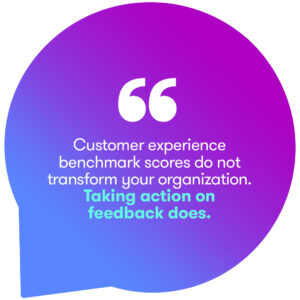
Why should brands enable action across their entire organization?
In today’s customer-driven economy, the customer experience either leaves a positive or negative impression. Was the experience convenient? If I needed help, could I find an employee to assist me? Did the store have my size in stock? Was the digital shopping experience easy and frictionless? Was I able to accomplish my shopping and purchasing goals? Did the contact center agent understand the reason why I was calling and work to resolve it on the first call? When the customer answers these example questions “no,” experience breakdowns happen leaving the customer with a negative view of the brand causing customer churn, impacting size of cart and customer lifetime value. Additionally, customers tell their negative experience stories in various channels – surveys, contact center transcripts, online reviews, social media, etc.
As consumers, we all want to feel heard. We want our challenges, frictions and negative experiences resolved. We want to engage with brands. The challenge is that most companies overlook the impact of taking action by closing the loop with the customer.
What is closing the loop?
Close the loop feedback (CLF) is the process by which feedback from customers is shared with employees, action is taken to respond to the customer feedback (Inner Loop), and action is taken to improve core processes, products and systems (outer loop).
Who is responsible for closing the loop?
Inner Loop – typically, this is your frontline team across the organization (store employees, contact center agents, digital chat agents, and even the direct supervisors and/or managers that support the frontline).
Outer Loop – this is the cross-functional support teams within your organization (marketing, operations, digital product managers, legal, technology, finance, audit, and any other function within your organization).
Why is closing the loop important?
Closing the loop is important because it directly shows customers and employees the company cares, and drives internal operational improvements that ultimately result in better customer and employee experiences.
Additionally, taking action and closing the loop enables a brand to close their Experience Gap while realizing the positive business outcomes all brands desire – increased same stores sales, sell through rates, customer acquisition, reduced churn, repeat visits and increased customer lifetime value.
Additional benefits of closing the feedback loop…
Improving Customer Response Rates – A Chatter study of 15 retail brands and 500,000 customer alert closures found that closing the loop with customers increased their response rate by 5.4% in the trailing 12-month time period. On the other hand, brands that did not close the loop witnessed a decline in response rates by 3.8% in the same time period.
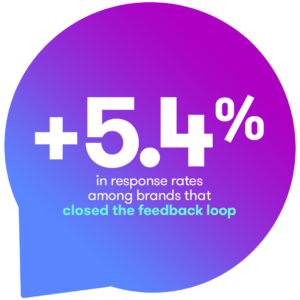
Increasing experience metrics (NPS, CSAT, OSAT) – That same Chatter study found that when a brand closed the loop with a detractor (customer who had a negative experience and is therefore less likely to recommend the brand), the customer cohort NPS improved by 16 points in the trailing 12-month time period.
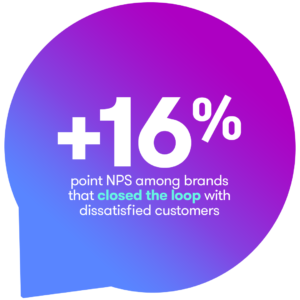
Reducing Cost to Serve – A global retail brand was feeling the pressures of the labor shortage in their contact center. They were experiencing increased call volumes due to digital frictions as well as a spike in negative business outcomes.
The experience team used Chatter to ingest all call center transcripts, help them understand the reasons for the calls, and analyze the sentiment associated with each conversation between the customer and agent. The customer experience team was able to democratize these insights with the eCommerce team, directly influencing the prioritization roadmap while optimizing high-impact digital enhancements. This retail brand noticed a 17% decrease in call volumes over the following 6-month period.
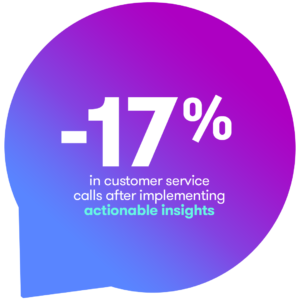
Increased Customer Lifetime Value – A North American retailer became laser focused on closing the loop with all detractors and resolving all negative feedback their brand received across their 1,800 retail locations. The brand enabled their frontline store managers and assistant managers to receive alerts, triggering a close-the-loop contact attempt. During this process, the goal was to resolve the customer issue and win back the customer relationship. As a result, the retail brand experienced an increase of 14% in dollars spent and a 6% increase in store visits.
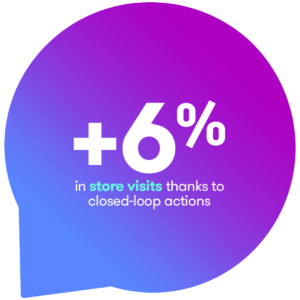
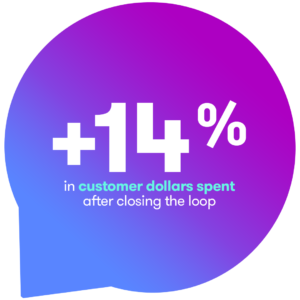
Want to implement a closed-loop system of your own? Part 2 will give you a blueprint for success.
Engage, act, close the loop
Taking action at scale not only improves the customer relationship, but also enables the organization to improve profitability by prioritizing high–value, high–importance initiatives. Too many leaders deprioritize closing the loop due to labor shortages or a lack of visibility into the operational impact of their actions. In the long term, this only hurts the brand. Take action! Start now!

Connect with Zack for a chat
Zack Hamilton
Senior Vice President, Chief Experience & Strategy
![]()
![]()